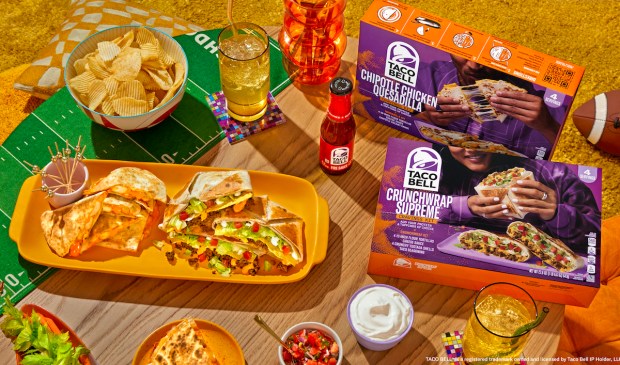
As restaurants look to capture more of consumers’ day-to-day meal occasions, Taco Bell is going after shoppers’ grocery spending, selling meal kits in Walmart stores.
The Yum Brands subsidiary announced Thursday (Jan. 4) the launch of meal kits based on its popular Crunchwrap Supreme and Chipotle Chicken Quesadilla menu items, created in partnership with food giant Kraft Heinz, in an exclusive deal with Walmart.
“A partnership founded on a mutual obsession with their consumers, Kraft Heinz and Taco Bell created the Taco Bell at Home line to bring signature and crave-worthy Taco Bell offerings and flavors straight to the grocery aisle and allow fans to make Taco Bell their way,” Kraft Heinz Associate Director of Developing and Established Brands Danielle Coopersmith said in a statement.
The news comes as, across the restaurant industry, key players have been looking to create new sales opportunities by launching grocery product lines. In turn, these products enable restaurants to insert their brands into more of consumers’ day-to-day meal occasions.
For instance, in the fall, Chuck E. Cheese expanded its licensed frozen pizzas to Walmart stores. Around the same time, P.F. Chang’s launched salad kits based on its menu. Over the summer, Tim Hortons debuted its packaged cold brews in U.S. grocers, and Panera Bread drove sales of its grocery products with a tie-in with its restaurant loyalty program.
Plus, economic pressures have made grocery sales more appealing to restaurants, as budgetary constraints have forced many consumers to pull back on restaurant dining.
“Our customers are looking for more ways to stretch their budget,” Kroger CEO Rodney McMullen said on an earnings call last year. “The gap between food at home and food away from home spending grew … as more customers gravitated toward affordable meal solutions that restaurants simply can’t provide. Our research shows that cooking at home is three to four times less expensive than dining out.
Many consumers are abstaining from restaurants altogether. The PYMNTS Intelligence study “Consumer Interest in an Everyday App,” which drew from a March survey of more than 3,300 consumers in the United States and Australia, found that 27% of consumers in the U.S. had not made a restaurant purchase at all in the previous 30 days.
Additionally, overall, the lines between the restaurant and grocery categories have been blurring in recent years, with key players in each industry trying to gain a share of total food spending.
PYMNTS Intelligence’s study earlier this year, “Connected Dining: Ready-to-Eat Meals are Eating Restaurants’ Lunch,” which drew from an April survey of more than 2,300 U.S. adults, revealed that 57% of consumers had bought ready-to-eat meals in the past month, and 28% reported purchasing ready-to-eat meals every week. Among ready-to-eat customers, 65% bought these meals at the grocery store.
“The grocery store is trying to be the one-stop shop,” Geoff Alexander, president and CEO of restaurant brand Wow Bao, which sells its products in Walmart and other supermarkets, told PYMNTS in an interview last year. “Whether it’s for ready-to-eat meals, food for another night, or the typical grocery shop, they’re trying to entice the consumer to use the grocery store in many different ways.”